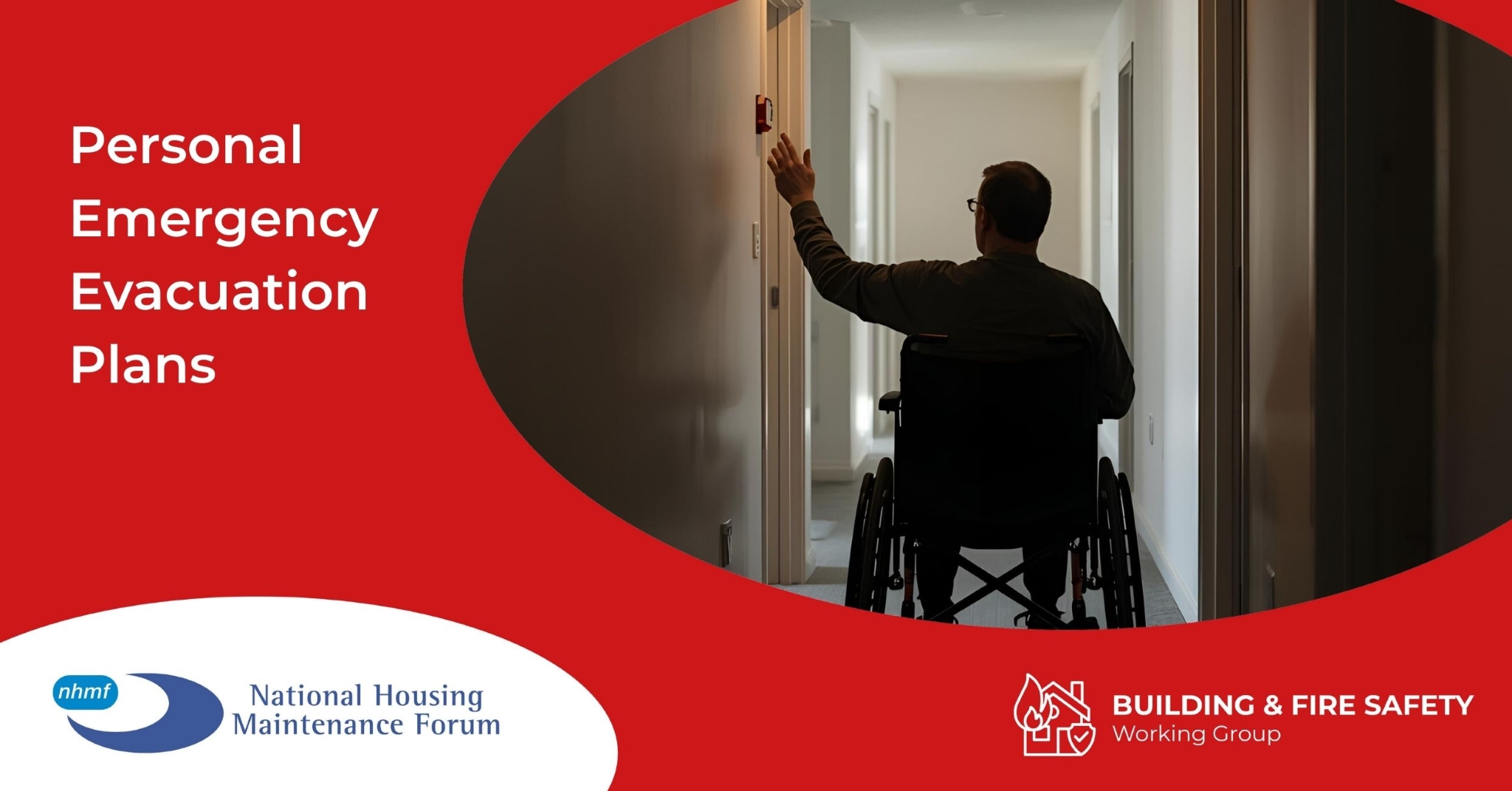Personal Emergency Evacuation Plans: Preparing for the New Fire Safety Landscape
Neil Watts, Lead of the National Housing Maintenance Forum’s Working Group on Building and Fire Safety, and Peabody Property Services Group Director of Asset Compliance & Building Safety, discusses the latest regulations on PEEPS (Personal Emergency Evacuation Plans), sharing how Peabody is responding, and gives insight into how housing associations and councils can meet this challenge.

The PEEP Revolution: What Housing Providers Need to Know
The National Housing Maintenance Forum’s (NHMF) role is to promote best practice in the social housing maintenance sector, and the Building and Fire Safety Working Group wants to highlight how PEEP regulations will fundamentally reshape how providers need to approach fire safety. Personal Emergency Evacuation Plans (PEEPs) represent more than just another compliance requirement – they embody a complete shift towards personalised, resident-centred fire safety planning.
The Fire Safety (Residential Evacuation Plans) (England) Regulations 2025 mean all residents with disabilities and impairments will be entitled to "a person-centred fire risk assessment to consider their specific individual risks and ability to evacuate in the event of a fire." Coming into effect on 6th April 2026, these regulations will require housing associations and councils to develop individualised evacuation strategies for residents who cannot independently escape during emergencies.
The regulations will apply to all buildings containing two or more sets of domestic premises which are at least 18 metre high, have seven storeys or are above 11 metres and have a simultaneous evacuation strategy requiring all residents to leave the building immediately in the case of a fire.
The ‘responsible person’ of a building (the person who owns or manages the building) must prepare a separate building emergency evacuation plan, share this plan with their local Fire and Rescue Authority and – in the event the building has a secure information box – place a copy of the plan in the box. A Secure Information Box (SIB) is a lockable box in a high-rise residential building mandated by Fire Safety (England) Regulations 2022 in response to recommendations from the Grenfell Tower Inquiry Phase 1 report. The hard copy of the PEEPs in the SIB acts as a backup to the fire and rescue services digital copies and mitigates the possibility of arrival with incorrect or incomplete information caused by failures of information technology.
The Scale of the Challenge
The numbers paint a sobering picture of the sector's impending responsibilities. Home Office impact assessments estimate that "between 131,000 and 248,900" vulnerable residents in high-rise buildings could potentially require PEEPs. With "almost half of high-rise residential buildings classified as social housing," the burden will fall disproportionately on housing associations and local authorities already stretched by record spending on repairs and maintenance.
This represents a seismic shift in fire safety philosophy. As the UK Governments states, the new approach means "resident consent is needed throughout every stage of Residential PEEPs" – residents cannot be compelled to participate, yet providers must create comprehensive systems to identify and support those who need assistance.
Implementation Hurdles: Beyond Compliance
The practical challenges are mounting rapidly. Housing providers must navigate complex consent requirements whilst ensuring vulnerable residents aren't discriminated against by being inadvertently excluded from life-saving support. The Local Government Association has received legal advice suggesting "councils and housing associations have an anticipatory duty to consider the requirements of those who are unable to self-evacuate, without those residents having to ask."
Data protection concerns add another layer of complexity. Providers must balance transparency with privacy, ensuring that no personal data beyond the number of the property and number of affected persons will be included in the PEEP without the residents’ explicit consent.
Best Practice Emerging: Learning from Early Adopters
In anticipation of the new regulations, housing associations like Peabody already have systems in place to capture residents’ needs, especially for higher risk buildings. However, this will be expanded and frameworks refined to ensure every aspect of the regulations are met.
Organisations that are forward looking should be investigating if there are reasonable and proportionate measures to mitigate the risk to evacuating residents and how these costs can be covered either by individuals, shared where there is a benefit to the majority of residents or by accessing Government funding designed to support PEEP implementation. If residents need some particular piece of equipment to ensure their safe evacuation, there's grant funding around that, both for the management team and also for the equipment to be provided to the individual. The devil, as always, will be in the detail but the NHMF remains committed to keeping members informed as this funding landscape crystallises.
The regulations require review every 12 months so updating mechanisms are proving crucial. However individual residents’ circumstances can often change before the review date, meaning resources need to be allocated to support this eventuality.
Seizing the Opportunity
Despite the challenges, PEEPs offer opportunities for providers to demonstrate genuine commitment to resident welfare. The regulations mandate a person-centred fire risk assessment discussion that should lead naturally to the resident being able to decide what they should do in the event of a fire.
Successful implementation requires investment in staff training, robust data management systems, and partnership working with Fire and Rescue Services. Providers must develop clear pathways for self-identification whilst ensuring no vulnerable resident falls through the cracks.
The Path Forward
As the April 2026 implementation date approaches, housing providers face their most complex fire safety challenge yet. Those who embrace PEEPs as an opportunity to strengthen resident relationships, rather than merely another compliance burden, will emerge stronger. The key lies in treating each plan not as a bureaucratic exercise, but as a potentially life-saving conversation between provider and resident.
To keep up to date with this issue visit the ‘Best Practice’ page of the NHMF website then browse by topic to ‘Fire safety’. Here you will find the latest regulations, our explanations of them and guidance on how to approach them.
Working for everyone to create a better social housing landscape
We’re called Working Groups because that’s precisely what we’re doing – working, not just talking and meeting. If you’d like to join us working on behalf of creating a better social housing landscape by becoming a member of this Building and Fire Safety Working Group or the 6 other areas our Working Groups cover; Procurement, Healthy Homes, Net Zero, Technology, Training, Skills & Culture or Hammar regional please contact: neil.watts@peabody.org.uk

